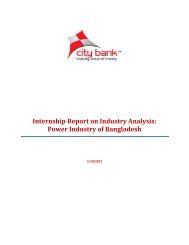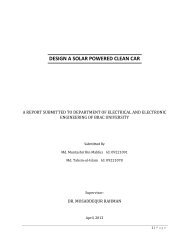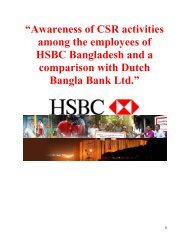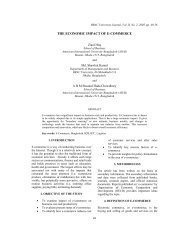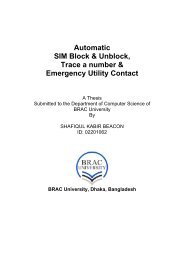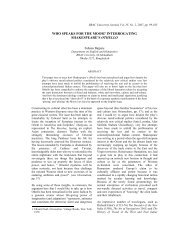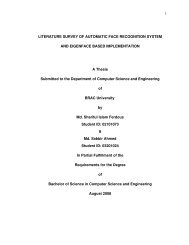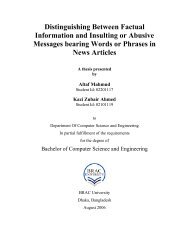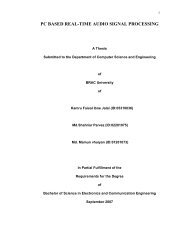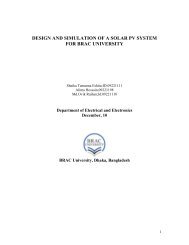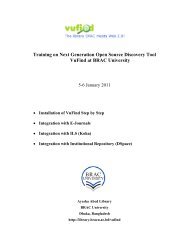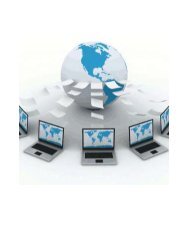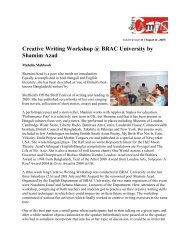Evaluation of Entry into Ice cream Business - BRAC University ...
Evaluation of Entry into Ice cream Business - BRAC University ...
Evaluation of Entry into Ice cream Business - BRAC University ...
Create successful ePaper yourself
Turn your PDF publications into a flip-book with our unique Google optimized e-Paper software.
2.2.2 Surviving the Great Depression:<br />
The Great Depression struck not long after the new company was formed. As prices and pr<strong>of</strong>its<br />
around the world threatened to collapse, Unilever had to act quickly to build up an efficient system <strong>of</strong><br />
control. But it was not until the end <strong>of</strong> World War II that Unilever began to recognize the important<br />
relationship between marketing and research. In the meantime, Unilever expanded its U.S. operations<br />
through two important acquisitions: Thomas J. Lipton Company, manufacturer <strong>of</strong> tea and the<br />
Pepsodent brand <strong>of</strong> toothpaste.<br />
2.2.3 Post-war Era: Adapting to New Markets and Technology:<br />
Unilever's greatest achievements between 1945 and 1965 were its adaptation to new markets and<br />
technology. Unilever's strategy was to acquire companies in new areas, particularly food and<br />
chemical manufacturers. Among the post-war acquisitions were U.K. frozen foods maker Birds Eye<br />
(1957) and U.S. ice <strong>cream</strong> novelty maker Good Humour (1961). The advent <strong>of</strong> the European<br />
Economic Community, or Common Market, also created new opportunities for Unilever.<br />
2.2.4 Restructuring and Major Acquisitions<br />
In the 1980s Unilever undertook a massive restructuring. The company sold most <strong>of</strong> its service and<br />
ancillary businesses, such as transport, packaging, advertising, and other services that were readily<br />
available on the market, and went on a buying spree, snapping up some 80 companies between 1984<br />
and 1988. Specifically, Unilever's core businesses were detergents, foods, toiletries, and specialty<br />
chemicals.<br />
2.2.5 Twenty First Century Unilever:<br />
Unilever's fastest growing market in the early 1990s was in Asia. Asian sales <strong>of</strong> personal products,<br />
detergent, and packaged foods were growing more than twice as fast as sales in the United States<br />
and Europe. Unilever continued to make acquisitions in the mid-1990s, completing more than 100<br />
purchases between 1992 and 1996, more than half <strong>of</strong> which were in foods. In 1993 Unilever gained<br />
the number one position in the U.S. ice <strong>cream</strong> market through the completion <strong>of</strong> two acquisitions. One<br />
the largest acquisitions <strong>of</strong> this period was the 1996 takeover <strong>of</strong> Chicago-based Helene Curtis<br />
Industries Inc., manufacturer and marketer <strong>of</strong> personal care products, primarily shampoo and<br />
conditioners, hand and body lotions, and deodorants and antiperspirants.<br />
Unilever ended the 20th century with the launch <strong>of</strong> Path to Growth, a five-year strategic plan that<br />
included a focus on top brands within core market sectors and an emphasis on growth within<br />
developing countries. In the face <strong>of</strong> considerable competitive pressures in various markets around the<br />
world – particularly from Procter & Gamble, the company announced that it would eliminate about<br />
1,200 <strong>of</strong> its brands to focus on around 400 regionally or globally powerful brands.<br />
<strong>Evaluation</strong> <strong>of</strong> <strong>Entry</strong> <strong>into</strong> <strong>Ice</strong> <strong>cream</strong> <strong>Business</strong> for Bangladesh Limited 7



